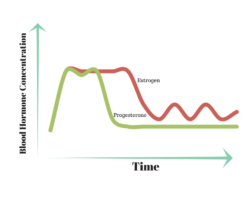Hepatitis C is an extremely contagious, blood-borne virus that currently infects about 4 million Americans. Its transmission occurs through direct contact with the infected blood. The tricky part here is that most people who carry the hepatitis C virus in their blood do not have any symptoms. Only very mild, vague symptoms such as fever, fatigue, joint pain, nausea, and vomiting may appear. For more than 75% of people who get the Hepatitis C virus, the infection does not go away; they rather develop a chronic infection that, over time, leads to liver failure and an elevated risk of liver cancer (that’s where “Hepatitis” gets it’s name from)!
Although the prevalence of HCV has been steadily rising since its discovery in 1989, a marked increase in its diagnosis has been noticed more recently by CDC, especially in the young lot. This increase parallels the rise in the misuse of opioids and heroin (injection drug use) in this age group.
However, while both men and women are susceptible to chronic Hepatitis C infection regardless of their gender, there are some factors contributing to an altered impact of the virus on men and women. These variations could lend some insight to future treatment, prevention, and research efforts.
Some ways in which HCV affects women differently are described below:
- Scarring of the liver or cirrhosis is a symptom seen in 5 to 20% of the infectious population (as per CDC). However, women seem to be more protected against liver cirrhosis than men. Experts believe that estrogen hormone is the savior here.
- Sharing intravenous drug needles is the easiest way to transmit Hepatitis C. According to a study published in the journal Emerging Infectious Diseases, researchers found that women are more likely to start using intravenous drugs with a sexual partner than men are.
- Of those infected with hepatitis C, most develop chronic infection. The rest who are able to get rid of the virus without medication are the ones whose bodies have a spontaneous clearance system. Spontaneous clearance seems weighted towards women, based on a 2014 study published in the journal Hepatology. Researchers suspect estrogen’s liver protective property to be partly responsible for this.
- Studies show that up to 3% of people in a monogamous relationship with a Hepatitis C-positive partner become infected through unprotected sexual intercourse. Hepatitis C infection, like HIV, is likely to be more efficiently transmitted through anal sex than through vaginal intercourse because of the greater risk of blood exposure. And when a woman is having her menstrual period, the virus gets transferred from the woman to her partner through her blood.
- Because it can remain asymptomatic for years, many people are not even aware of having Hepatitis C. Before Hepatitis C was identified (1970s and 80s), women who went through C-section surgeries and received blood transfusions, are likely to be diagnosed with Hepatitis C today.
- Ribavirin is frequently used in combination with other medications to treat Hepatitis C. A common but serious side effect of ribavirin is anemia (low red blood cell count). For women on ribavirin, this automatically becomes a much bigger concern as they already lose blood each month through menstruation. Thus, menstruating women on ribavirin should have their blood cell levels monitored regularly.
- Estrogen-containing pills (used in case of birth control or HRT) are not advisable for women with chronic Hepatitis C infection. This is because a damaged liver may not be able to break down these hormones.
To sum up, women demonstrate a slow rate of disease progression until menopause. Vertical transmission of HCV occurs, but data supporting recommendations for prevention of mother-to-infant transmission are limited.
References:
- Women With Chronic Hepatitis C Virus Infection
- Hepatitis C and women of childbearing age
- What Women Need to Know About Hepatitis C

Cesarean Section Surgery Explained
The cesarean section surgery rate is about a third of all births in the US. However, for a procedure so common, there’s astonishingly scant information about how and why cesarean sections are performed. Read More..

HRT for Menopause Treatment
When the female body crosses the childbearing years, the hormone levels start fluctuating and dropping, making the body go through numerous changes in order to cope up with the stress. This is the period of ‘menopause’, and these dwindling hormones,.. Read More..









